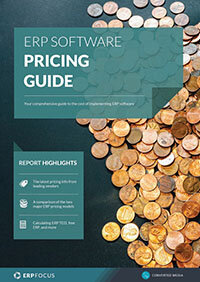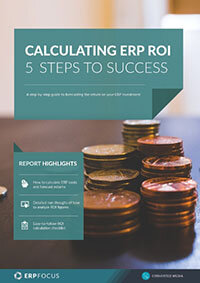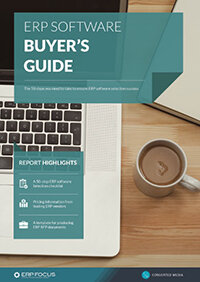28 cost elements to include in your ERP TCO calculation
The modern definition of total cost of ownership (TCO) was established in the mid-80’s by Gartner Research, although prior to this event, the concepts of identifying, calculating and measuring the cost of known operational expenses had been applied since the industrial age. However, the emergence of new technologies, primarily in the form of computing and software systems, required a different slant on previously accepted cost accounting methods. Consequently, in the ERP market, the Gartner definition became the ultimate rule rather than the exception.
GET ERP RESEARCH & KNOWLEDGE RIGHT TO YOUR INBOX
Covering the key issues faced by businesses selecting and implementing ERP.
Without going through a formal discourse regarding TCO, in practical terms, the term total cost of ownership suggests how much money an enterprise will be required to purchase, prepare for, and initiate a full-span ERP installation. In this article, I’ll define four tiers of focus; however, please bear in mind that every enterprise is different, so be prepared to apply your own subjective thinking to this taxonomy.
Get your free ERP pricing guide for a complete guide on ERP pricing, projected costs, and budgets
Necessary adds
The goal of this section is to define and establish each term, so that enterprise knowledge engineers can identify necessary focus items while attempting to discard as much hyperbole as possible.
Again, some tiers and/or individual elements may be irrelevant to your own situation, but better to consider each element in your TCO calculation to see which applies, rather than miss something important that later becomes a hidden cost.
Capital development
In formal terms, this means “…the expansion of established firms.” However, the term can also be applied when enterprises’ desire to grow business systems, such as the purchase and implementation of an ERP system, while mitigating impacts on measurable enterprise cash flow.
From a TCO calculation perspective, measured costs can include:
Principal pay-back: original investment value, including opportunity costs and initial purchase price, etc.
Interest: the cost of borrowing to acquire or construct a long-term asset.
Potential pay-off penalties: additional costs calculated on the original investment value including late fees, payment schedule extensions, other administrative/legal costs, etc.
Equity/share costs over time: extended costs relating to the completion or modification of investment monies associated with a final purchase. This element can also be calculated on the basis of ‘share points’ where equity is delivered rather than being tendered as a cash value.
This tier should also be considered in the context of cost elements, including:
- Risk management, i.e., potential vulnerabilities (discussed further below)
- Upgrade availability (discussed further below)
- Patch and future license management, etc.
- Insurance costs
- Scalability expenses (discussed further below)
Software
Digitized sets of instructions resulting in the manipulation, management, and consolidation of individual data records, and/or a formal structure that delivers meaningful business/user information. In the case of a consolidated ERP platform, this definition can be represented by one or more modules integrated within a single system infrastructure.
Core platform: In ERP, this term typically applies to modules that relate to the general ledger, accounts receivable, accounts payable, payroll, and/or Inventory; although in manufacturing, it also specifically relates to a host of production elements such as scheduling, raw materials management, and various other critical path modules.
Operational security: In the past, security systems were largely seen as discrete, value-added components in the enterprise ERP segment. However, as cloud computing has become more prominent, fully integrated security elements have emerged.
Nevertheless, from a TCO perspective, the cost of implementing a full-span security system should be seen as a stand-alone component, in order to ensure that any affiliated costs are identified accurately.
Low-level utilities: similarly to security systems, today’s cloud-based systems typically include necessary utilities as part of their operating infrastructure. However, while the cloud approach appears to be emergent, certain enterprise types still demand more traditional approaches to ERP operations.
For example, certain process manufacturers, such as pharmaceutical operators, tend to appreciate hybrid or even stand-alone systems best due to necessary policy and/or regulatory requirements. Consequently, TCO cost calculations must always be defined by constraints set by the market itself.
Custom builds: this cost calculation typically applies to cloud-based systems, although hybrid and stand-alone ERP systems have become so sophisticated that up to 15% of all resource platforms encompass some level of customization. Consequently, to understand the practical cost of a particular platform, all-in costs must be calculated and included within a TCO analysis.
Linking code: in the same way that code customization has become critical to today’s ERP operations, affiliate or linked code bases that connect current with legacy-based systems must apply to any accurate TCO evaluation.
Training and educational applications: more times than not, TCO analysis fails to account for training and educational system costs. Part of this problem relates to a perception that knowledge-based systems are not typically seen to be relevant costs relating to the ERP platform itself.
However, to be somewhat blunt, no one has ever seen a resources-based system run itself, populate itself with data, or use resultant information to put a buck on the bottom line. Consequently, don’t fool yourself when you’re calculating the cost of ownership of an ERP implementation, because the ERP system doesn’t make money; well-trained workers do.
Ongoing training programs: as one might expect, this is a follow-on cost component relating to core training/education. Sometimes, an enterprise may be able to simply run the same workforce programs until folks get the point, but more times than not, they don’t for a host of reasons.
Consequently, it’s always a good idea to leave some cost margin in the training budget just in case you have to try a different set of educational precepts.
Process re-engineering costs: your existing processes will need to be optimized to make them more efficient, and improve or implement best practices instilled from your ERP. Although this can be time-consuming, it can be a lot cheaper than the alternative of customizing an ERP system to fit an existing (non-profitable) process.
Get our free ERP implementation guide for step-by-step instructions on each ERP implementation phase
Process auditing costs (both internal and external): existing software processes need to be evaluated and audited for many factors, including system usage, functional ERP usage, and to find processes that need to be further optimized for re-engineering. This means hiring someone or having existing personnel perform an ERP audit, which takes time, and we all know - time means money.
This tier should also be considered in the context of cost elements, including:
- Installation and integration of hardware and software costs
Systems implementation
Systems implementation is the process of ensuring that an information system reaches an overall operational standard. Some process elements are more critical than others, and consequently, demand more unconventional cost scrutiny at a TCO level. Here are some of the usual suspects.
Data migration: assuming that an ERP implementation is driven by an upgrade from one ERP system to another, many folks fail to account for the cost of migrating one datastore to another, newer, variant. Consequently, if you find yourself in this situation, mind this caveat, since in many cases the cost of successfully migrating mass data from one system to another can be from 10% - 15% of its final total cost of ownership.
Upgrades: In many cases, this cost component may appear to be as useful as calculating the future value of a dollar, since it is largely based on something that hasn’t happened yet. Nevertheless, take the time to investigate these costs and apply them within any TCO to avoid any nasty surprises downstream.
Infrastructure testing: if this element isn’t being accounted for in a proper ERP TCO calculation, it should be. Consider this: if a shiny ERP platform seems to run like a pig, rather than a racehorse, it’s likely that somewhere in the bowels of the enterprise’s infrastructure, something is slowing the whole thing down.
As a result, bear in mind that no enterprise system stands alone, even if it’s housed in the cloud. So, ensure that you cost-account for any test programs to ensure that all pipes leading to and from the ERP platform are free from bottlenecks.
Elements in this case include:
Systems testing: As the old saying goes, time is money. The more times you test an ERP platform before you launch, the more stable that system will become. So, take the time to test the ‘guts’ of your enterprise, while also costing out any time necessary to prove stability, not guess at it.
In this case, testing includes;
- Installation and initial stability
- Pre-move data stability
- Post-data-migration stability
- Module integration run-throughs
- Pre-launch stability
- Post-spin-up tests
Stand-in and special personnel costs: Did you hire an ERP consultant during your implementation? The consulting fee must be included in your total cost of ownership in an ERP system implementation, as well as additional expenses that may accumulate.
Risk management: considering and identifying potential vulnerabilities, upgrading availability, patching, and future license management, etc. This includes compliance assurance reviews, risk prioritization, and internal sign-offs.
Scalability expenses: as your business grows, your ERP needs will likely grow with it, which means implementing new modules, adding more users, or upgrading the system completely (if upgrades aren’t included in the purchase/subscription cost). If two years after implementing, you choose to add an additional 50 users and two modules, then this needs to be accounted for in your TCO calculation.
Project management costs: how much it costs to keep the implementation running smoothly: this includes the cost of the team members keeping the ERP project on track, and your project manager (internal or external).
Legacy platform decommissioning costs: your old system will be switched off, and your new system will be the new way of life, but there are important real-world elements to consider, such as closing your legacy system to new transactions, reducing the availability of your legacy ERP, and ultimately removing the legacy ERP completely.
This tier should also be considered in the context of cost elements, including:
- Infrastructure enhancement costs
- Power costs i.e,. affiliate equipment, climate systems, backup power systems
- Insurance costs
People
This tier should be self-evident; however, calculating how much a workforce costs, in terms of defining an accurate TCO, can help make or break an enterprise budget after the fact.
This tier should be considered in the context of cost elements, including:
Downtime and outage costs: This is the amount of time your system is offline, usually during implementation, resulting in non-productive hours or hours when customers are unable to submit orders.
Reduced productivity costs: i.e., acclimatization to the system, and diminished money-making ability. Your employees’ wages remain the same, but their productivity is limited until the new system goes online. Don’t leave this ‘soft cost’ out of your TCO calculation, or the cost of buying a support program to cover the time lost.
ERP project team responsibilities: your ERP project needs to be equipped with your best personnel to ensure your system meets all requirements and runs smoothly. This means that your ERP project team will be spending a lot of time on the ERP project, rather than on their day-to-day duties, which means either providing cover for their existing position or an increase in labor hours.
All of these elements, along with virtually every other hidden element that costs more than the price of a paperclip, should be applied to an ERP TCO to understand where one’s budget is going. Cost, not revenue, is often the primary gating issue when it comes down to executing a successful ERP project.
List of ERP TCO cost elements
- Networking hardware and software costs
- Server hardware and software costs
- Workstation hardware and software costs
- Installation and integration of hardware and software costs
- Data migration costs
- Risk management; i.e., potential vulnerabilities, upgrade availability, patches, and future license management, etc.
- Infrastructure enhancement costs
- Power costs, i.e., affiliate equipment, climate systems, backup power systems
- Quality assurance and testing costs
- Downtime and outage costs
- Reduced productivity costs, i.e., acclimatization to the system, diminished money-making ability
- Security, including potential breaches, loss of brand reputation, recovery, and future prevention
- Backup systems management and recovery costs
- Training and user adoption costs
- Process auditing costs, i.e,. internal and external
- Process re-engineering costs
- Insurance costs
- Stand-in and special personnel costs
- Project management costs
- Future upgrade or scalability expenses
- Legacy platform decommissioning costs
- Capital development, including principal pay-back, interest, potential pay-off penalties, equity/share costs over time
- Upgrade availability
- Scalability expenses
- Operational security
- Customization
- Training and educational applications, including ongoing training
- Systems testing
By now, it should be clearer than before that all critical elements relating to the development and calculation of an accurate TCO are paramount. The best enterprise in the world, mated with the most cutting-edge ERP system, will fail if cost awareness is not maintained throughout an implementation since this particular technical expansion sets up nearly everything else that follows.
ERP platforms are not like other enterprise systems since they tend to subsume every other affiliate system, rule, and policy within a typical business operating infrastructure. Consequently, over time, the ERP platform itself becomes the most critical revenue driver and begins to form the backbone of all revenue-bearing operations.
However, if an enterprise is unwilling or unable to understand its total cost of ownership at the implementation, costs can run away over time. This lack of sensitivity can hurt a company’s bottom line and could even cause a complete failure. So, developing an accurate TCO process is important as a general matter, but is even more necessary when it comes to an ERP involvement.
Free white paper

ERP Software Pricing Guide
Get the latest pricing information on over 80 popular ERP systems, and learn how to budget for your ERP project in our free guide

Featured white papers
-

ERP Software Pricing Guide
Get the latest pricing information on over 80 popular ERP systems, and learn how to budget for your ERP project in our free guide
Download -

Calculating ERP ROI: 5 steps to success
Calculate your new ERP's financial benefits with this comprehensive guide
Download -

ERP software buyer's guide
Save hours of ERP selection research with this comprehensive buyer's guide
Download
Related articles
-

Top ERP systems for small businesses
Which ERP solutions are best for small business needs? Information on features, scalability and m...
-

CMMC Compliance: What Aerospace and Defense Manufacturers Need to Know
Key insights on CMMC compliance, deadlines, and securing DoD contracts with CMMC 2.0 certificatio...
-

How to conduct a thorough ERP audit
The types of ERP audit, and step-by-step instructions on how to audit your ERP system

